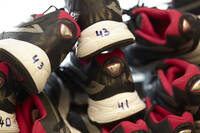PainRelief.com Interview with:
Laurent Malisoux, PhD
Group Leader, Public Health Research
Department of Population Health
Luxembourg Institute of Health

PainRelief.com: What is the background for this study?
Response: Pronation refers to the way the foot rolls inward during the gait cycle. Foot pronation during running is normal, but over-pronation (increased amount or poor timing) has previously been related to the risk of running-related injury. Indeed, alterations in the movements at the foot-ankle complex results in abnormal repetitive load, and may subsequently lead to an injury at the foot-ankle complex or more proximally in the kinetic chain. A previous trial demonstrated that motion control shoes reduced the risk of injury in recreational runners.1
Importantly, in the previous trial, the effect of motion control shoe was investigated on all injury types concurrently. However, risk factors as well as mechanisms underlying the development of injury might differ across injury types. Thus, motion control shoes may only be effective in preventing some injury types, and the effect might be partially masked if it is assessed on different injury types concurrently.
The present study is a secondary analysis of the abovementioned trial. Based on previous literature, we assumed that some injury types, namely Achilles tendinopathy, plantar fasciopathy, exercise-related lower leg pain and anterior knee pain, were related to over-pronation and were defined as pronation-related running injuries, while other running-related injuries are not. We hypothesised that motion control shoes aiming at reducing excessive pronation would reduce the risk of pronation-related running injuries in recreational runners compared to shoes with no motion control technology.
PainRelief.com: What are the main findings?
Response: Motion control shoes reduced the risk of pronation-related running injuries in regularly active recreational runners, but had no protective effect on other running-related injuries. The hazard ratio to develop pronation-related running injury was almost 2.5 times lower with motion control shoes versus standard shoes. When compared to the results of the initial trial (which included all injury types), the effect of the motion control shoes versus standard shoe was much greater on pronation-related running injury while the significant effect disappeared for other running-related injuries.

PainRelief.com: What should readers take away from your report?
Response: This study actually tells two standalone stories.
The first story targets clinicians and suggests that motion control shoes might be recommended for runners who are prone to Achilles tendinopathy, plantar fasciopathy, exercise-related lower leg pain patellar tendinopathy and anterior knee pain, which were defined as pronation-related running injuries in the present study.
The second story targets researchers and stresses the importance of investigating the effect of an intervention or the association of risk factors taking into account the most plausible underlying mechanism, and therefore, focusing on the most relevant outcome. Otherwise, there is a possibility that the effect of an intervention is overlooked, and consequently, the intervention considered ineffective.
PainRelief.com: What recommendations do you have for future research as a result of this work?
Response: In prospective studies, several different types of injury occur during the follow-up, while often only one injury type is of interest. Injuries not of interest were frequently removed from analyses in previous studies, which may give rise to biased estimates. Furthermore, the occurrence of one type of event hinders or influences the occurrence of other types of events. The importance of competing risk analysis in situations when an individual can experience more than one type of event has previously been emphasised.2 Research aiming to identify risk factors for injury or investigate the effect of an intervention should distinguish between injuries that are related to that risk factor/intervention and injuries that are not.
On another note, the evidence for a causal relationship between over-pronation and injury risk in running is poor. Consequently, further research is needed to define injury types causally related to over-pronation.
The trial was conducted by the Sports Medicine Research Laboratory, Luxembourg Institute of Health. It was co-funded by the Ministry of Higher Education and Research in Luxembourg and Decathlon SA, France. The present study was conducted at the Ghent University in collaboration with the Luxembourg Institute of Health.
References:
1.Malisoux L, Chambon N, Delattre N, Gueguen N, Urhausen A, Theisen D. Injury risk in runners using standard or motion control shoes: a randomised controlled trial with participant and assessor blinding. Br J Sports Med 2016; 50(8):481-487.
2. Nielsen RO, Malisoux L, Moller M, Theisen D, Parner ET. Shedding Light on the Etiology of Sports Injuries: A Look Behind the Scenes of Time-to-Event Analyses. J Orthop Sports Phys Ther 2016; 46(4):300-311.
Citation:
Title: Motion Control Shoes Reduce the Risk of Pronation-Related Pathologies in Recreational Runners: A Secondary Analysis of a Randomized Controlled Trial
J Orthop Sports Phys Ther. 2020 Dec 11:1-31. doi: 10.2519/jospt.2021.9710
The information on PainRelief.com is provided for educational purposes only, and is in no way intended to diagnose, cure, or treat any medical or other condition. Always seek the advice of your physician or other qualified health and ask your doctor any questions you may have regarding a medical condition. In addition to all other limitations and disclaimers in this agreement, service provider and its third party providers disclaim any liability or loss in connection with the content provided on this website.d
Last Updated on December 17, 2020 by PainRelief.com
